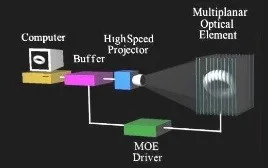Several years ago, LightSpace Technologies Inc. (Riga, Latvia, Twinsburg, OH and San Jose, CA) offered a 3D volumetric display product. The product was not successful and the company went out of business. The latest news is that the company has been reconstituted and is preparing to offer new versions of the display product.
One of LightSpace Technologies volumetric display products.
Aspects of the company are discussed in a video that can be found at the end of this article.
First, a few words of background information. The LightSpace display system consists of two main components. The first is a high speed, single-chip DLP engine that is used for rear projecting video onto the second main component. The second component is a stack of about 20 air-spaced screens. The arrangement of the screens can be visualized as similar to the slices in a loaf of bread. Each screen is individually electrically addressable and can be driven to quickly switch from a transparent state to a scattering state. More specifically, each screen in the so-called Multi-planar Optical Element (MOE) is a liquid crystal scattering shutter. In previous versions of the LightSpace display, the MOEs were composed of Polymer Dispersed Liquid Crystal material. The latest version of the MOEs is reported to use a new liquid crystal formulation.
The operation of the LightSpace system is illustrated with reference to the figure below.
A high-speed video projector rear projects a sequence 2D image slices received from a computer into the Multi-planar Optical Element where each slice is halted at the proper depth to create the volumetric 3D image.
Proprietary multi-planar anti-aliasing algorithms are used to smooth the appearance of the stack of image slices to produce a volumetric 3D image with a continuous appearance.
Features of the LightSpace approach are claimed to include:
- Matched accommodation and parallax eye depth cues for all displayed 3D content.
- Can be viewed at an arbitrary distance with eye fatigue substantially reduced as compared to that typically experienced at a short viewing distance with stereoscopic 3D displays.
- 90 degree field of view with full motion parallax in both horizontal and vertical directions.
- Eyewear not required.
- No eye tracking required.
- Supports multiple, simultaneous viewers.
The company plans to offer three models. The specifications of model x1406 represent an upgrade from those of the previous model x1405. The Model x1500 is under development.
Other features of the x1406 as compared to the x1405 include:
- Reduced acoustic noise from the fans.
- The light engine has increased brightness and an added “white” self-calibration option.
- The x1406 is less expensive than the x1405.
One of the chief challenges in the design of a LightSpace type volumetric display is bandwidth. Two factors contribute to this problem.
The first is the capability of the single-chip engine. The LightSpace application requires that it run much faster than in other, more conventional applications due to the fact that there are multiple image planes. The result is that currently, the image has only 5-bits per color with a screen update rate of 20 Hz.
A second limitation to the frame rate is how fast the MOE screens can be switched. At this time, 20 fps is the top end for a color image. The company notes, however, that if grayscale only images are displayed, there is an option to offer 12 bps at ~50 fps or 5-8 bps at ~100 fps.
The x1405 is available for order right now. The x1406 will be available “soon.” The x1500 is planned to be ready this fall. All models are planned to be available for demonstration, rent and purchase. The company has stated that other demonstration models with different screen sizes and architecture are under development. -Arthur Berman

